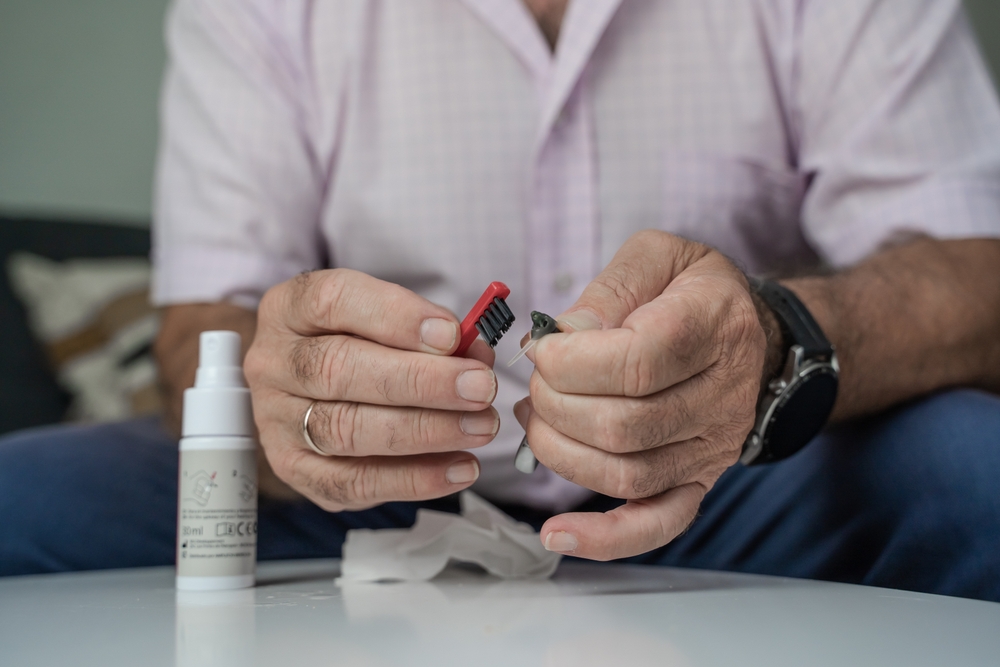
For individuals with hearing loss, hearing aids are crucial for improved hearing and total quality of life. They do, however, need to be routinely cleaned and correctly maintained just like any technology does. The lifespan of your device can be significantly extended by regular cleaning which will also allow you to hear more clearly. In this guide, we’ll walk through the steps to properly clean and care for your hearing aids.
Keeping your hearing aids clean and getting professional tune-ups
To keep your hearing aids functioning at their best, daily or weekly cleaning is essential. A quick cleaning routine doesn’t take very long but goes a long way in maintaining sound quality and device longevity.
In addition to your regular at-home care, periodic professional maintenance by a hearing professional is advised. Think of it like going to the dentist, while brushing and flossing help, professional cleanings ensure the best results. A deep clean by a specialist is recommended every six months or so. This helps to detect any issues your device might have and helps keep it in prime working condition.
Simple care guidelines for daily use
The performance and lifespan of your hearing aids can be substantially enhanced by utilizing these few basic tips. Consider the following guidelines to avoid common pitfalls:
- Clean Before Bed: Cleaning your hearing aids at night gives them a chance to dry completely before you wear them again in the morning.
- Wash Hands Before Handling: Always wash your hands before touching your hearing aids to avoid transferring oils or debris that could interfere with their function.
- Protect From Extreme Temperatures: Avoid exposing your hearing aids to extreme weather conditions. Leave your hearing aids inside your home if the weather is particularly hot and humid or cold and wet outside.
- Keep Them Free of Moisture and Chemicals: Moisture and chemicals can be damaging to your hearing aids. Before going for a swim, showering, or using products like hair spray, be sure you remove them.
- Safe Storage: When not in use, keep your hearing aids stored in a protective case or in their charging unit to prevent exposure to dirt or physical damage.
- Use a Dehumidifier: Storing your hearing aids in a dehumidifier at night can help keep them dry and free of moisture that could cause malfunction.
Tools for proper hearing aid care
You will need the appropriate tools to effectively maintain your hearing aids. Think about investing in a hearing aid care kit, which could include the following:
- Hearing aid dryer: Dries any moisture built up after using the device all day.
- Wax pick or loop: For gently cleaning out earwax from small crevices.
- Microfiber cloth: Ideal for wiping down the surface of your hearing aids.
- Slim tube cleaner: For getting rid of debris stuck in the tubes.
- Cleaning brush: For getting rid of dust and wax accumulation.
Our hearing specialists can help you keep your hearing aids in great working order by guiding you to the appropriate tools and maintenance techniques.
Cleaning varies depending on the type of hearing aid
Different models of hearing aids require somewhat different cleaning methods. Two of the main types of hearing aids are Behind-the-ear (BTE) and In-The-Ear (ITE): Here are precise cleaning instructions for each type.
Cleaning In-The-Ear (ITE) hearing aids
- Brush Debris Away: Gently wipe away any earwax or debris from the surface of your hearing aid while holding it face down.
- Remove Wax with a Loop: Use a wax loop or pick to carefully remove any remaining earwax.
- Wipe the Exterior: Wipe down the whole outer surface with a microfiber cloth to clear away any residue.
- Clear the Ventilation Tube: Push a thin cleaning tool through the vent tube to ensure there’s no blockage.
How to clean Behind-The-Ear (BTE) hearing aids
- Clean the Microphone Openings: Brush the opening of the microphone to ensure they’re clear of debris.
- Use a Wax Pick: Eliminate any stubborn wax with a loop or pick.
- Clean the Aid: Carefully wipe off any dirt or wax while holding the device face down, paying specific attention to the area around the receiver and microphone.
- Soak the Ear Mold: Loosen any buildup on the ear molds by detaching them and soaking them in warm soapy water. Get rid of any excess moisture with a tubing blower and finish with a dry cloth.
- Detach the Tubing: Begin by separating the tubing from the hearing aid itself.
- Clear the Tubing: Run a pipe cleaner through the tubing to remove wax or moisture, then clean the outside with a cloth.
- Reassemble and Test: Once everything is dry, reassemble your hearing aids and test to make sure they’re working properly.
Protecting against ear infections with effective hygiene
Cleaning your ears is just as important as keeping your hearing aid clean. Excessive accumulation of earwax can negatively impact the function of your hearing aid and cause your ears discomfort and potentially infection. These issues can typically be avoided by routinely cleaning your ears and hearing aids.
Schedule a professional hearing aid cleaning
If you have any concerns about your hearing aids or would like to schedule a professional cleaning, reach out to us today.
Professional maintenance is key to ensuring your hearing aids continue to work well for years to come.